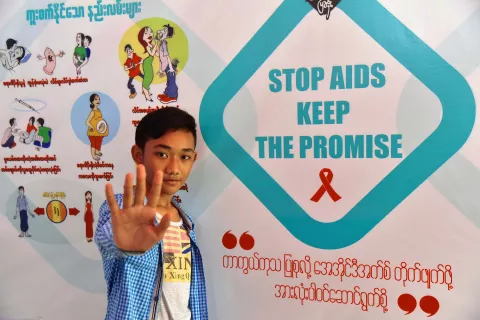New HIV infections among adolescents projected to rise by nearly 60 per cent by 2030 if progress stalls – UNICEF
Urgent action needed to improve HIV prevention and treatment for young people
- Available in:
- 中文
- English
NEW YORK/JOHANNESBURG 1 December 2016 – New HIV infections among adolescents are projected to rise from 250,000 in 2015 to nearly 400,000 annually by 2030 if progress in reaching adolescents stalls, according to a new report released by UNICEF today.
"The world has made tremendous progress in the global effort to end AIDS, but the fight is far from over - especially for children and adolescents," said UNICEF Executive Director Anthony Lake. "Every two minutes, another adolescent - most likely a girl - will be infected with HIV. If we want to end AIDS, we need to recapture the urgency this issue deserves - and redouble our efforts to reach every child and every adolescent."
AIDS remains a leading cause of death among adolescents, claiming the lives of 41,000 adolescents aged 10-19 in 2015, according to the 7th Stocktaking Report on Children and AIDS: For Every Child: End AIDS.
The report proposes strategies for accelerating progress in preventing HIV among adolescents and treating those who are already infected. These include:
- Investing in innovation including in locally grown solutions.
- Strengthening data collection.
- Ending gender discrimination including gender-based violence and countering stigma.
- Prioritising efforts to address adolescents' vulnerabilities by providing combination prevention efforts including pre-exposure prophylaxis, cash transfers and comprehensive sexuality education.
UNICEF support for an AIDS Free Generation in China
UNICEF works with the government of China, civil society partners and sister UN agencies to ensure that all babies, children, adolescents and their mothers are able to access life-saving HIV prevention, testing, treatment, care and support.
Since the initiation of UNICEF supported prevention of parent-to-child transmission (PPTCT) pilot programme in 2001, the Government of China has scaled up the national programme to all counties of the country and is now targeting elimination of parent to child transmission of HIV. A comprehensive network of testing and medication, high-quality maternal and child health services, community-based support groups and peer counseling was gradually established and expanded to protect every pregnant woman, mother, child and adolescent to survive and thrive. The combined efforts under UNICEF's support led to a sharp decline in the rate of mother-to-child transmission (PPTCT) of HIV from 34.8% to 6.1% in 2014. Moreover, the percentage of parent-to-child transmission among all new HIV infections declined from 1.6 % in 2005 to 1.1% in 2014.
In China, home to over 270 million children and adolescents, the rate of new infections has steadily increased since 2012 among youth especially in key populations, and in particular, men having sex with men (MSM) and among youth living in high HIV-prevalence areas.
In 2015, UNICEF together with key international partners launched All IN – a global action formed by broad alliances to advocate for increased investment to end adolescent AIDS. As unprecedented global effort in the fight against HIV and AIDS, ALL IN promotes a data-driven planning exercise to improve strategic prioritization and programming for adolescents. Under the ALL IN partnership, in China, UNICEF is working with all partners, including the Government of China, civil society, youth groups and community organizations, to identify the key barriers and bottlenecks and deliver results for all young people, especially the most vulnerable and marginalized.
To achieve an AIDS free generation in China, we must truly reach children and young people in their first and second decade of life. We need better education to inform healthy choices, we need better data to target interventions. We must reduce stigma to encourage testing and put people and keep people on treatment. We must engage adolescents and our most at risk populations in shaping community and national responses. There is much work to be done,” said Rana Flowers, Representative UNICEF.
“It is time to reaffirm the global commitment to an AIDS-free future that the world has envisioned for the generations to come, and the actions taken today are important step toward achieving the ambitious Global Sustainable Goals by 2030.”
ABOUT ALL IN
To ensure the global target of ending AIDS by 2030 is achieved, adolescents must be front and center in the global AIDS response. In 2014, UNICEF and UNAIDS joined force with international society and governments and launched All In – a global action to end adolescent AIDS, forming broad alliances to advocate for increased financial, technical and service investment in adolescents, to reduce the multiple risks and vulnerabilities they are facing, so as to reduce new infections and AIDS related deaths among adolescents.
Media contacts
About UNICEF
UNICEF works in some of the world's toughest places, to reach the world's most disadvantaged children. Across 190 countries and territories, we work for every child, everywhere, to build a better world for everyone.
| Visit UNICEF Global website: www.unicef.org Visit UNICEF China website: www.unicef.cn Follow us on Sina Weibo: http://weibo.com/unicefchina Tencent Weibo: http://t.qq.com/unicef Wechat: unicefchina |



